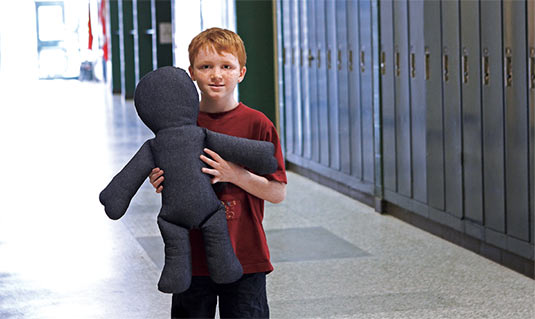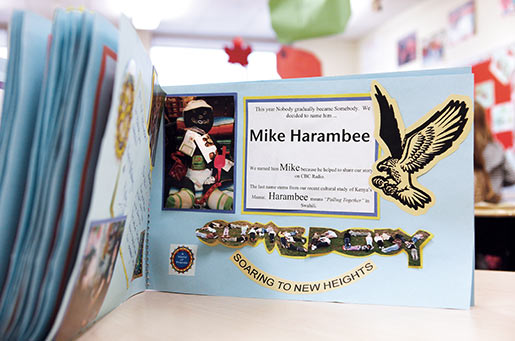|
Gold Medal Learningby Suzanne Blake, OCT |
In Character
Something from NobodyA Parent’s PerspectiveIt never occurred to me that a doll, a teacher and Africa would all come together to help send my eight-year-old son on a journey of self-discovery. The doll was part of a character education initiative called the Nobody Project. That’s where the journey began. by Karen HorsmanA suitcase arrived in my son’s Grade 2 class last year with Nobody inside. Nobody was a two-foot gender-neutral doll made of denim. The plan was that each student would take the doll home for a week, and during that time would show Nobody how to become Somebody by teaching it to be a good person. For example, they could clean up their local park to show it how to be environmentally responsible or hold a garage sale and donate the profits to a charity. My son Mark already had a passion for Africa. His teacher, Amber Currie, OCT, had done a unit on Africa earlier in the year, and he was smitten with the beauty of the dry earth and huge animals. He had also seen TV commercials about children suffering from malnutrition in places like Nairobi. He often told me that it “bugged him” that kids were hungry. Once the students had their cause, it was up to them to come up with a plan.
When I talked to Mark’s teacher, she said, “I love the hands-on idea of the project. The kids have to identify someone or something that needs help. Mark just picked it up and ran with it.” Did he ever. We found out about something called Plumpy Nut or peanut-paste medicine. It’s often called the miracle food that saves children’s lives. Mark raked leaves for neighbours and managed to raise $40. I knew he was disappointed and had wanted to raise more. Before returning the doll to the classroom, he was required to attach to it a symbol of his good deed. Mark put a leaf in a sandwich bag and hung it on the doll like a necklace. The next student to get the doll was Cameron. Her birthday was coming up, and in lieu of presents, she asked for donations so she could adopt a snow leopard at the Toronto Zoo. “Cameron already had it in her heart to do this,” her mother told me. “But having that opportunity at school made a nice connection between home and the classroom.” So Nobody soon had a fancy baseball cap from the zoo with a snow leopard on it, and then it was on to the next student. By the end of the year, Nobody was decorated with many attachments and had transformed into a Somebody. For me, the best part came at the conclusion of the project when Amber Currie issued the students a challenge. She asked them how they would continue to help those in need. “It was easy to tell that Mark was already working on another idea,” she told me. “The seed had been planted.” 
The class ended up naming their doll. They called him Mr. Harambee. Harambee means pulling together in Swahili. When the new school year started in September, my son was fortunate enough to have Amber Currie again. He went to her and said, “I want to hold a bake sale.” This time he planned to raise $500 for peanut-paste medicine. I knew the school would have to reject the bake sale because of allergy concerns, but I wanted Mark to learn how to problem solve. I decided to sit back and see where this was going. He went to meetings with the principal and his teacher on his own. Mark was convinced that he could make a difference. It was just a matter of figuring out what he would be allowed to do. Ms. Currie encouraged Mark to spread the word about malnutrition and Africa. With some help, he came up with a presentation on Plumpy Nut that he delivered to his class. He and his brother and sister worked on information posters and school announcements. He settled on hot chocolate and cookies to sell at school concerts. He did flyers to collect donated boxed cookies to keep his costs down.
It was a ton of work and there were lots of bumps along the way, but for me there is one memory that will always outshine the rest. Mark came home one day and said, “Mom, these two little girls came up to me in gym and said, ‘Are you Mark?’ And I said, ‘Yes,’ and they handed me two Ziploc bags with ‘Africa donation’ written on them. It was really cool!” The school was buzzing about Plumpy Nut. Thanks to Nobody, Mark had been able to start a conversation. A conversation about what sorts of things we can all do to help. The staff and students raised $600 for Plumpy Nut. “The beauty of the project is that the kids can build on their own strengths,” said Amber Currie. “And then help a cause that’s close to their heart. It’s not forced on them.” The class ended up naming their Nobody doll who became a Somebody. They called him Mr. Harambee. In Swahili, harambee means pulling together. The journey continues for Mark. He’s asked if he can meet some people with the organization Doctors without Borders to find out more about malnutrition and Plumpy Nut. When I asked if he wanted me to set that up he said, “As long as it doesn’t interfere with recess, I’ll be there.” For a kit or information about Who is Nobody? visit www.whoisnobody.com or write to info@whoisnobody.com. Camp characterImagine what you might achieve if you put the three Rs aside for a few days and spent the whole time on character development. As it turns out, selected Ontario students have the chance to experience just such an environment at the Ontario Educational Leadership Centre. Located near Orillia along the shore of picturesque Lake Couchiching, the centre runs week-long leadership camps that immerse children in the types of values that appear on character-development lists, says James Pinhorn, OCT, a Toronto high school teacher who facilitates one of the camps. Take co-operation, for instance. “The kids do large-group exercises like maneuvering floor mats to get to a pylon or making a square with a rope while blindfolded,” he explains. “They quickly learn that they can’t possibly succeed without co-operation.” Over the course of the week, Pinhorn says, the children’s empathy takes a tremendous leap forward. “In one session there was a very overweight boy who was being teased and mocked by the other kids. By the end of the week the kids were all cheering for him and pointing out his good qualities. If I hadn’t seen it with my own eyes, I wouldn’t have believed it.” Can schools duplicate such an experience? “It’s possible, if the school and community can agree that exploratory, non-competitive learning is time well spent,” Pinhorn muses. The caveat: “You have to build in strategies to ensure the flashy students don’t drown out the quieter ones, which sometimes happens in the classroom setting. Every student has to experience being heard and respected, as well as listening – that’s what gives the group process its power.” Pinhorn’s son Ben, a Grade 7 student who attended the camp last year, says the atmosphere of encouragement allowed him to gain insight into his own shortcomings. “One thing I learned about myself is that I’m not always nice to people,” he says. “After I got back from the camp, my friends told me they noticed I’m being more supportive and tactful to others. I think the change will stick. I hope it will, anyway!” ResourcesEvents
Organizations
Publications
|








